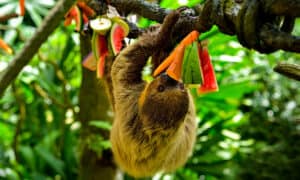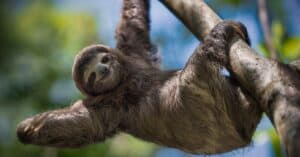Sloths have changed quite a bit in the last ten thousand years. The slow-moving, sleepy, leaf-eating creature we see hanging from tree branches today, is a far stretch from the sloth of the past. Today these animals are small and live primarily in Central and South America.
Ten to twenty thousand years ago the Mylodon, an enormous ground sloth, ruled the Americas. Previously, researchers believed that this ground sloth survived solely on plants, much like today’s sloths. However, a new study from the American Museum of Natural History indicates that this might not be the case.
The Mylodon
Though now extinct, the Mylodon is one of history’s most insane animals. Estimated to weigh between 2,000 and 4,000 pounds and growing nearly ten feet tall, these sloths looked and behaved very differently from their future descendants.
The Mylodon roamed the Americas. Researchers have found their skeletal remains as far north as Alaska. Some of these remains suggest even larger varieties of Mylodons. One skeleton was measured to be the size of an elephant!
Based on previous research of the Mylodon’s dental characteristics, preserved excrement, jaw biomechanics, and today’s sloths’ diets and activities, researchers assumed the Mylodon was also a herbivore. However, with new research tactics, researchers were able to analyze the biochemical compounds within keratinous body tissues, such as hair and fingernails, to determine the Mylodon’s and other extinct sloth’s diets.
Findings
Researchers used the preserved keratinous tissues of seven extinct sloth and anteater species as well as some from living species with known diets to compare the biochemical makeup, specifically nitrogen isotopes, and determine the contents of the animals’ diets.
Looking at the amino-acid nitrogen values within these chemical compounds, researchers are able to compare present-day sloth’s diets with those of their extinct ancestors. This comparison can show irregularities or other chemicals within the body tissues that are consistent with carnivorous dietary behaviors. They can also determine animals’ diets on a trophic level meaning they can see if a species were solely herbivores, mixed omnivores, exclusively meat-eating carnivores, or fish and marine animal consumers. This research is important because of its impact on our understanding of historic ecosystems.
When comparing the extinct sloth species with the living species, researchers found inconsistencies that suggested the Mylodon was not in fact a herbivore like they previously believed. The study clearly classified the Mylodon as an omnivore, meaning this extinct sloth species had a combination diet of plants and other animals.
Impact
By discovering new information about the diet of the Mylodon, researchers can begin to reexamine the current ecologic beliefs about the South American ecosystem ten thousand years ago. Presently, it is known that South America could not have supported the number of supposed herbivores who subsisted off plant-exclusive diets. By determining that one of the system’s major players, the Mylodon, was not a herbivore opens the door for additional research in the diets of other known species in the region.
This research also raises questions about evolution and how Mylodons eventually evolved into today’s plants-only sloths. By continuing to research these ancient diets and gather more data on the chemical makeup of extinct South American species, researchers will eventually be able to paint a clearer picture of the region’s past and evolution to present day conditions.
The photo featured at the top of this post is © iStock.com/Parkol
Thank you for reading! Have some feedback for us? Contact the AZ Animals editorial team.






